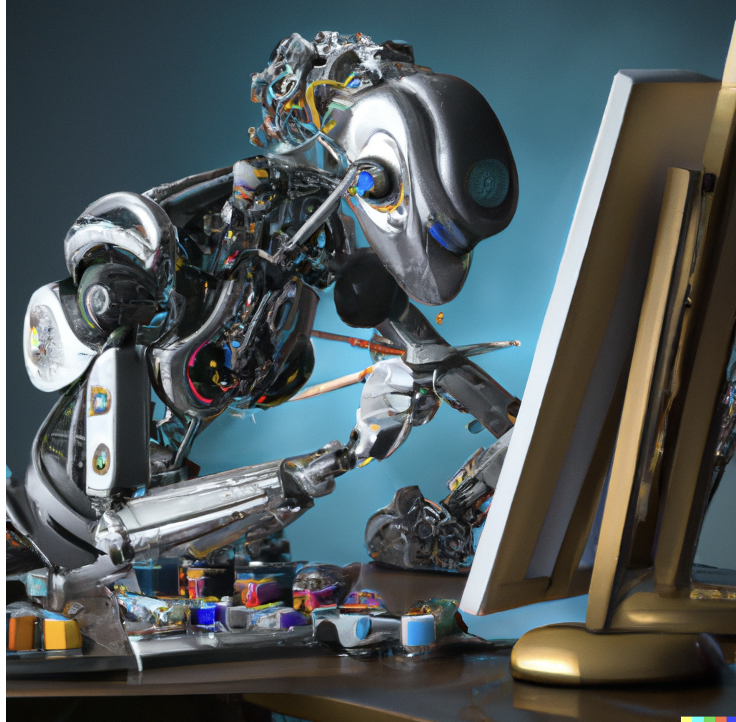In recent times, Artificial intelligence (“AI”) has quickly erupted and touched upon every corner of society. From improving the quality of everyday life and seemingly fictional concerns, AI technology has developed an essential part of society—the ability to create. From its inception in the 20th century, AI has made itself a powerful tool in society.[i] Most recently, artificial intelligence has advanced and made such a revolutionary impact in the modern world that legal questions have risen. More specifically, over the last year, generative artificial intelligence models have been able to create art, music, and code leading to various pressing copyright concerns. Currently, the most urgent question in AI technology is whether it is an author for purposes of copyright protection. While there is no clear determination, the answer may lie in the joint-authorship doctrine of copyright law.
The novel legal issues come from the recent innovations in generative AI. Merely a decade ago, the state-of-the-art models of artificial intelligence were only capable of generating blurry, fingernail-sized black-and-white images of faces.[ii] The low quality of these images then did not create a threat to humans, meaning that legal concerns and battles were still a part of a fictional world. However, in recent years, software like Stable Diffusion, which creates images in response to text prompts, can now be used to copy an artist’s style or create work using other artists’ work.[iii] Moreover, AI has been developed to generate art, music, and other pieces of art independent from human involvement. However, this technology still relies on human data to generate their own work. As such, AI technology creates potential copyright issues when companies and individuals attempt to sell the work without the previous artist’s consent. Furthermore, the lack of legal guidance regarding AI technology may leave companies and individuals without legal protections or recourse if they create work using AI technology. The current legal issues raised by AI technology developments are not as simple as addressing copyright infringement. Instead, artificial intelligence raises the question of whether AI can be an author for copyright infringement purposes.
The Copyright Act protects original works of authorship fixed in any tangible medium of expression. Further, creative works will qualify for copyright protection only if they are original works created by a human author.[iv] As such, the U.S. Copyright Office will refuse to register a claim if it determines that a human being did not create the work. However, corporations have previously been recognized as authors under the work-for-hire doctrine.[v] Similarly, AI could be addressed as a non-human author under the joint-author doctrine of copyright law.
Before current advancements in AI technology, copyright issues had yet to be at the forefront of the legal field, given that computer-generated works were merely a tool–similar to a pen-and-paper–in creating any other work of art. While AI technology goes beyond a simple pen-and-paper analogy due to its potential for autonomy outside human commandment; providing AI co-authorship status could provide protection and limitations to its use in creating art.[vi] The joint-authorship doctrine provides that when more than one author prepares a work with the intention that their contribution is merged into inseparable or interdependent parts of a unitary whole, the work will be recognized as the co-owner of the copyright. Typically, human authorship is required because an artificial person may not sue or be sued. However, in the context of joint authorship, legislatures may expand their scope to include non-human co-authors, similar to how corporations may be seen as authors for purposes of work-for-hire doctrine.
Courts and legislatures will have to either deny copyright protection for works created by a computer or it can create authorship of such works to the program’s creator. Both solutions have potential holes that could further create concerns for copyright laws in artificial intelligence and creative works. For example, if courts determine that the computer-generated work has authorship, who receives the benefits of copyright protection? Or, in the alternative, if courts and legislatures refuse to give protection to computer-generated works, how will this impact the way creative works advance in society– in other words, will it hold back the development of creativity? Soon, legislators will be forced to draw a careful line between AI authorship and inevitable conflicts with intellectual property laws.
More specifically, legislatures must carefully consider intellectual property policies, which are premised on incentivizing creators to produce artistic, scientific, and technological works of value to society. The risk of stagnating creativity and protecting individual property rights is a battle that intellectual property laws are often faced to fight; and with the developments and our ever-changing society, it seems like this battle has just begun.
[i] See generally History of Artificial Intelligence, Council of Europe Portal, https://www.coe.int/en/web/artificial-intelligence/history-of-ai (last visited Mar. 10, 2023).
[ii] James Vincent, The Scary Truth About AI Copyright is Nobody Knows What Will Happen Next, The Verge (Nov. 15, 2022), https://www.theverge.com/23444685/generative-ai-copyright-infringement-legal-fair-use-training-data.
[iii] See generally Yasmine Leung, What is the Stable Diffusion AI and How Does the Image Generator Work? HITC (Dec. 20, 2022), https://www.hitc.com/en-gb/2022/12/20/what-is-stable-diffusion-ai-and-how-does-the-image-generator-work/.
[iv] See United States Copyright Office, Copyrightable Authorship: What Can Be Registered, Compendium of U.S. Copyright Office Practices(2014), ://www.copyright.gov/comp3/chap300/ch300-copyrightable-authorship.pdf.
[v] See generally Justin Hughes, True Authors and the Work-for-Hire Doctrine – Part I, The Media Inst., Mar. 25, 2010), https://www.mediainstitute.org/2010/03/25/true-authors-and-the-work-for-hire-doctrine-part-i-2/ (explaining that when the employer is a corporation, the employer is not the person closest to the actual creative process).
[vi] See generally Andres Guadamuz, Artificial Intelligence and Copyright, WIPO MAGAZINE (Oct. 2017), https://www.wipo.int/wipo_magazine/en/2017/05/article_0003.html (explaining that rapid development of machine learning software produces an autonomous system that are now capable of learning without being specifically programmed by a human).



